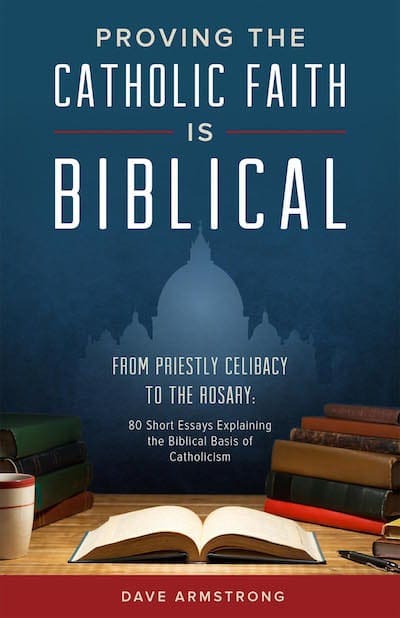The Perpetual Virginity of Mary
Once upon a time, virtually no Christians — including Protestants — denied that Mary the Mother of Jesus was perpetually a virgin. Of the early leaders of the Protestant movement, including Luther, Calvin, Zwingli, Bullinger, and Cranmer, virtually all fully accepted this doctrine. Moreover, most Protestant exegetes continued to believe it for at least another 350 years or so.
But today (for various reasons) things are very different, so it’s helpful to revisit the biblical arguments, since the Bible is the authority all Christians revere. A surprising number can be found: 1. Luke 2:41-51 describes Mary and Joseph taking Jesus to the Temple at the age of twelve, for the required observance of Passover. Everyone agrees that He was the first child of Mary, so if there were up to five or more siblings, as some maintain (or even one), why is there no hint of them at all in this account?
2. Neither Hebrew nor Aramaic has a word for cousin. The New Testament was written in Greek, which does have such a word (sungenis), but Jesus and His disciples spoke Aramaic (a late version of Hebrew), and the Hebrew word ach is literally translated as adelphos, the literal equivalent of the English brother. In the Bible, it has a very wide range of meanings beyond “sibling,” just
as brother does in English. Thus, it is routinely used in the New Testament to describe cousins or kinsmen, et cetera.
3. Jesus Himself uses brethren (adelphos) in a nonsibling sense. In Matthew 23:8 (cf. Matt. 12:49-50), He calls, for example, the “crowds” and His “disciples” (23:1) “brethren.” In other words, they are each other’s “brothers”: the brotherhood of Christians.
4. In comparing Matthew 27:56, Mark 15:40, and John 19:25, we find that James and Joseph (mentioned in Matthew 13:55 with Simon and Jude as Jesus’ “brothers”) are the sons of Mary, the wife of Clopas. This other Mary (Matt. 27:61; 28:1) is called our Lady’s adelphe in John 19:25. Assuming that there are not two women named Mary in one family, this usage apparently refers to a cousin or a more distant relative. Matthew 13:55-56 and Mark 6:3 mention Simon, Jude, and “sisters” along with James and Joseph, calling all adelphoi. The most plausible interpretation of all this related data is a use of adelphos as “cousins” (or possibly, stepbrothers) rather than “siblings.” We know for sure, from the above information, that James and Joseph were not Jesus’ siblings. It’s not mere special pleading to argue in this fashion (as is charged), or an alleged desperation of Catholics who supposedly “read into” the texts their prior belief in the dogma of perpetual virginity. Plenty of Protestant exegesis and scholarship confirms these views: especially in older commentaries. For example, the prominent nineteenth-century Commentary on the Whole Bible, by Jamieson, Fausset, and Brown, states, regarding Matthew 13:55 (my italics added):
An exceedingly difficult question here arises — What were these “brethren” and “sisters” to Jesus? Were they, First, His full brothers and sisters? or, Secondly, Were they His step-brothers and step-sisters, children of Joseph by a former marriage? or, Thirdly, Were they His cousins, according to a common way of speaking among the Jews respecting persons of collateral descent? On this subject an immense deal has been written, nor are opinions yet by any means agreed. . . . In addition to other objections, many of the best interpreters . . . prefer the third opinion. . . . Thus dubiously we prefer to leave this vexed question, encompassed as it is with difficulties.
5. The Blessed Virgin Mary is committed to the care of the apostle John by Jesus from the Cross (John 19:26-27). Jesus certainly wouldn’t have done this if He had brothers (all of whom would have been younger than He was).
6. Matthew 1:24-25 says, “Joseph . . . knew her not until she had borne a son.” This passage has been used as an argument that Mary did not remain a virgin after the birth of Jesus, but the same Protestant commentary also states (my italics again):
“The word “till” [until above] does not necessarily imply that they lived on a different footing afterwards (as will be evident from the use of the same word in 1 Samuel 15:35; 2 Samuel 6:23; Matthew 12:20); nor does the word “firstborn” decide the much-disputed question, whether Mary had any children to Joseph after the birth of Christ; for, as Lightfoot says, “The law, in speaking of the first-born, regarded not whether any were born after or no, but only that none were born before.”
John Calvin used the same counterargument in favor of Mary’s perpetual virginity. In fact, in his Harmony of the Gospels, commenting on Matthew 1:25, he thought the contention of further siblings based on this passage was so unfounded that he wrote, “No man will obstinately keep up the argument, except from an extreme fondness for disputation.”
In “Hebraic” use, the Greek adelphos applies to cousins, fellow countrymen, and a wide array of uses beyond the meaning of “sibling.” Yet it is always translated as “brother” in the KJV (246 times). The cognate adelphe is translated twenty-four times only as “sister.” This is because it reflects Hebrew usage, translated into Greek. Briefly put, in Jesus’ Hebrew culture (and Middle Eastern culture even today), cousins were called “brothers.”
Now, it’s true that sungenis (Greek for “cousin”) and its cognate sungenia appear in the New Testament fifteen times (sungenia: Luke 1:61; Acts 7:3, 14; sungenis: Mark 6:4; Luke 1:36, 58; 2:44; 14:12; 21:16; John 18:26; Acts 10:24; Rom. 9:3; 16:7, 11, 21). But in the KJV they are usually translated “kinsmen,” “kinsfolk,” or “kindred” — that is, in a sense wider than “cousin,” often referring to the entire nation of Hebrews. Thus, the eminent Protestant linguist W. E. Vine, in his Expository Dictionary of New Testament Words, lists sungenis not only under “Cousin” but also under “Kin, Kinsfolk, Kinsman, Kinswoman.”
In all but two of these occurrences, the authors were either Luke or Paul. Luke was a Greek Gentile. Paul, although Jewish, was raised in the very cosmopolitan, culturally Greek town of Tarsus. But even so, both still clearly used adelphos many times with the meaning of nonsibling (Luke 10:29; Acts 3:17; 7:23-26; Rom. 1:7, 13; 9:3; 1 Thess. 1:4).
Strikingly, it looks as if every time St. Paul uses adelphos (unless I missed one or two), he means it as something other than blood brother or sibling. He uses the word or related cognates no fewer than 138 times in this way. Yet we often Galatians 1:19: “James the Lord’s brother.” Despite the 137 other times that Paul uses adelphos to mean nonsibling, are we to believe that in this one case he must mean sibling? That doesn’t make any sense.
Some folks think it is a compelling argument that sungenis isn’t used to describe the brothers of Jesus. But they need to examine Mark 6:4, where sungenis appears: And Jesus said to them, “A prophet is not without honor, except in his own country, and among his own kin, and in his own house.” (cf. John 7:5: “For even his brothers did not believe in him.)”
What is the context? Let’s look at the preceding verse, where the people in “his own country” (John 6:1) exclaimed: “Is not this the carpenter, the son of Mary and brother of James and Joses and Judas and Simon, and are not his sisters here with us?” And they took offense at him.
It can plausibly be argued, then, that Jesus’ reference to kin (sungenis) refers (at least in part) back to this mention of His “brothers” and “sisters”: His relatives. Since we know that sungenis refers to cousins or more distant relatives, that would be an indication of the status of those called Jesus’ “brothers.”
Jude is called the Lord’s “brother” in Matthew 13:55 and Mark 6:3. If this is the same Jude who wrote the epistle bearing that name (as many think), he calls himself “a servant of Jesus Christ and brother of James” (Jude 1:1). Now, suppose for a moment that he was Jesus’ blood brother. In that case, why would he refrain from referring to himself as the Lord’s own sibling (while we are told that such a phraseology occurs several times in the New Testament, referring to a sibling relationship) and choose hear about instead to identify himself as James’s brother? Moreover, James also refrains from calling himself Jesus’ brother, in his epistle (James 1:1: “servant of God and of the Lord Jesus Christ”), even though St. Paul calls him “the Lord’s brother” (Gal. 1:19).
It’s true that Scripture doesn’t come right out and explicitly state that Mary was a perpetual virgin. But nothing in Scripture contradicts that notion, and (to say the same thing another way) nothing in the perpetual-virginity doctrine contradicts Scripture.
Moreover, no Scripture can be produced that absolutely, undeniably, compellingly defeats the perpetual virginity of Mary. The alleged disproofs utterly fail in their purpose. The attempted linguistic argument against Mary’s perpetual virginity from the mere use of the word brothers in English translations (and from sungenis) falls flat at every turn, as we have seen.
If there is any purely “human” tradition here, then, it is the denial of the perpetual virginity of Mary, since it originated (mostly) some seventeen hundred years after the initial apostolic deposit — just as all heresies are much later corruptions. The earliest Church Fathers know of no such thing. To a person, they all testify that Mary was perpetually a virgin and, indeed, thought that this protected the doctrine of the Incarnation, as a miraculous birth from a mother who was a virgin before, during, and after the birth.
+
This article is adapted from a section in Proving the Catholic Faith is Biblical by Dave Armstrong, which is available from Sophia Institute Press. Art for this post on Mary’s Perpetual Virginity: Cover and interior images used with permission.
Art for this post on Mary’s Perpetual Virginity: Cover and interior images used with permission.




